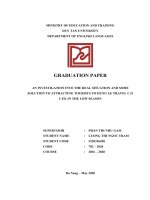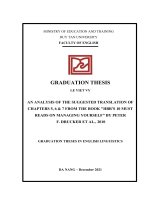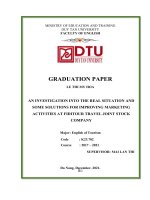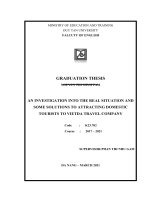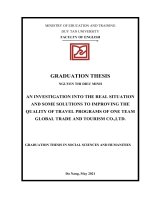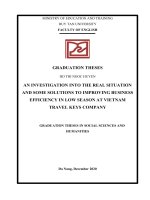Assessment on the actual situation and some silviculture practices for experimental forest of luot mountain in xuan mai chuong my ha noi
Bạn đang xem bản rút gọn của tài liệu. Xem và tải ngay bản đầy đủ của tài liệu tại đây (688.77 KB, 43 trang )
MINISTRY OF AGRICULTURE AND RURAL DEVELOPMENT
VIETNAM FORESTRY UNIVERSITY
STUDENT THESIS
ASSESSMENT ON THE ACTUAL SITUATION AND SOME SILVICULTURE
PRACTICES FOR EXPERIMENTAL FOREST OF LUOT MOUNTAIN IN
XUANMAI-CHUONGMY-HANOI
Major: Advanced Curriculum in Natural Resources Management
Code: D850101
Faculty: Forest Resources and Environmental Management
Student: VU TUAN ANH
Student ID:1053090896
Class: K55 Natural Resources Management
Course: 2010 – 2014
Advanced Education Program
Developed in Collaboration with Colorado State University, USA
Supervisor: Dr. Le Xuan Truong
Hanoi, October 2014
1
ACKNOWLEDGEMENTS
With the agreement and of the department of silviculture and Dr. Truong Le Xuan,
I have carried out a research on the projects: “Assessment on the actual situation and some
silviculture practices for experimental forest of Luot Mountain at Vietnam Forestry
University in XuanMai, ChuongMy. HaNoi”.
In the process of implementing topics, I have received the guidance and help of
teacher: Le Xuan Truong of the officials at Viet Nam Forestry University and professor
Lee Macdonald in Colorado State University. To have completed this topic, I would like to
express our sincere gratitude for that valuable help.
Despite great efforts by the energy and time are limited to topics inevitable
shortcomings. So the spirit realms and learn the requirements, I respectfully request that
we receive feedback from teachers and friends to more topics complete.
I would like to thank you!
2
ABTRACT
This thesis to investigate in depth the situation of some indigenous species growth
understory timber tree, then it give some solutions for resolving the existing problems.
First, it was conducted to the zone areas with favorable conditions for research and
investigation, it must have characteristic condition and consistent with the objective of this
thesis. Then, it will set up the standard plot and the sub-plot to measure the index of the
species in that areas. It can calculate statistical averages and compare them with each other.
The figures indicate that there are important issues of ecology needs to be resolve, such as
the competition about light, nutrients between indigenous species and timber tree. The
regeneration of timber tree are also additional in this thesis. Because it found that the
problem needs to be resolved, the thesis provides some silviculture practices to help the
timber tree have the space and good conditions for growth, and remove the bad individual
and the unnecessary canopy of indigenous species, as same as help to regenerate the timber
tree . The implementation of these measures will to increase the growth potential of
experimental forests, reduce the time to harvest, increased crop yields in the region,
creating a basis for developing forest sustainability and effectively .
3
TABLE OF CONTENTS
INTRODUCTION ................................................................................................................. 1
CHAPTER I: GOALS AND OBJECTIVES ......................................................................... 5
1.1 Goals: ………………………………………………………………………………...5
1.2 Specific objectives: ...................................................................................................... 5
CHAPTER II: METHODS .................................................................................................... 6
1.1 Desk research: .............................................................................................................. 7
1.2 Field works .................................................................................................................. 7
1.2.1 Set up standard plots method ............................................................................................ 7
1.2.2 Data collection .................................................................................................................. 8
1.2.3 Data processing method .................................................................................................... 9
CHAPTER III: RESULTS AND DISCUSSION................................................................. 11
1. RESULT. ..................................................................................................................... 11
1.1. The actual situation of timber trees. .................................................................................. 11
1.2. The actual situation of indigenous species. ....................................................................... 14
1.3. The situation of other species on research areas. .............................................................. 17
1.4. The situation of shrubs and vegetation on research areas. ................................................ 19
1.5. The comments about the condition and competitive relationships among species in the
research areas. .......................................................................................................................... 20
2. DISCUSSION .............................................................................................................. 22
CHAPTER IV: CONCLUSIONS. ....................................................................................... 24
REFERENCES
APPENDIX
4
INTRODUCTION
The research results on many countries in the world are shown that monoculture
plantations forest has exposed many weaknesses. So, scientists around the world were
interested in building models mixed species plantations forest to sustainable direction,
especially in the period of global climate change today.
The feature of mixed species forest is more structured canopy. So, re1search to create
the mixed species forest have many layers were number of scientists around the world
interested. When researching the canopy structure of the mixed species forest, the scientist
was shown that the canopy structure of mixed species plantations depends on the growth
characteristics and properties of populations of species in the forest. All of things are
shown that if we want to create models of mixed species plantations forest have a
reasonable structure, taking full advantage of the space nutrition should be based on
ecological characteristics as well as pay attention to the interrelationships among tree
species to choose the appropriate species. When studies of mixed species plantations, the
authors agree that the layout of the tree species in the models of the mixed species
plantations forest also have a clear influence on the growth of them and it depends on the
characteristics of each species and distance among individual species. This is the basis of
the decision is important to the success or failure of the mixed species plantations models.
Through these research are shown that indigenous species were more interested and
authors were selected for planting, the planting method may be planted in bands or clusters
to take advantage of space nutrition, research influence each other when mixed plantation
forest. However, these studies did not address the effects of the canopy cover of tree high
layers on the growth of other plants growing under the canopy. Therefore, the research of
the influence of canopy cover on the growth of native trees and understory planting
methods planting some indigenous species are needed, particularly for indigenous species
in Vietnam.
1
In Vietnam, the issues of planting mixed forests have been interested by scientists very
early. In the period 1930-1980, there are few studies on mixed species plantations and the
selected plant species researchers also focused some of Dipterocarpaceae. Since 1985, the
research about planting mixed forest by indigenous species to be deployed even more than
the number of tree species and plantation areas. During this period many indigenous
broadleaf tree species were selected to study the ecological zones in the country. The
indigenous broadleaf tree species was selected for study mixed species plantations are
mostly species have high economic value. Some indigenous plants was selected for the
Central Highland and the South of Vietnam are: Afzelia xylocarpa, Dalbergia oliveri, Xylia
xylocarpa, Tectona grandis... mainly at the experimental station of Trang Bom, Dong Nai
province, Lang Mang and Linh Lanh in Lam Dong province, Ekmat in Dak Lak province,
Tan Tao in Ho Chi Minh City. In the north of Vietnam, the main tree species selected for
planting mixed species forest are: Erythrophleum fordii, Peltophorum tonkinnensis,
Mechelia mediocris, Cinamomum ilcidioides, Manglietia conifera , Styrax tonkinensis,
Chukrasia tabularis, Ormosia balansae, Prunus arborea, Endospermum chinense.
Nowadays, there are many objects of the same old plantation monoculture forest in our
country has been transformed into the mixed different age forest, they will have structure
more stable and sustainable through the addition of some plants purpose planted according
to the different times.
The experimental forest of Luot Mountain of Vietnam Forestry University has an areas
of 130ha. Before 1985, the entire areas are planted forests and barren hills, the vegetation
composition mainly are some species of Myrtacese, Poaceae and small bushes. Wind,
sunny climate, degraded land with characteristics common ground is dry, acid, substance,
and rocky, soils with sesquioxides. Since 1985 - 1986, forestry universities have conducted
afforestation of barren hills covered by green plants pioneers such as Pine, Acacia,
Eucalyptus…Since 1993, the Research Experimental Forests Center of Vietnam Forestry
2
University conducted planted some indigenous tree species in this area. The period 1995 1996, the center continued deployment planting of indigenous species have been collected
from other provinces under the canopy of Pine and Acacia auriculiformis and then proceed
with additional plantings in the period 1996-2002.
The experimental of plantations mixed forest are planted in clusters in Vietnam Forest
University (Pham Xuan Hoan, 2004), have used 165 indigenous trees planted under the
canopy of Pinus massoniana, Acacia mangium, Acacia auriculiformis , which under the
canopy of Pinus massoniana are 27 species, under the canopy of Acacia auriculifomis are
21 species, the rest planted under the canopy of mixed forest of Pinus massoniana with
Acacia auriculiformis, Pinus massoniana with Acacia mangium, Eucalyptus. The survival
rate of the indigenous species under canopy of Pinus massoniana was assessed about
93.2% and understory of Acacia auriculifomis about 91.2%. Regular growth and average
growth of indigenous species have differentiation really clear. Especially, there are some
species often rated as slow growth: Cinamomum iners, Erythrophleum fordii to growth
well under the canopy of Pinus and Acacia.
In recent years, the Pinus and Acacia forest has well growth. Forest structure was
formed with its own characteristics of forest stand, the soil initial has been restored the
fertility, there are some indigenous tree species under the canopy of Pinus and Acacia was
11-18 years of age, a similar number of trees growth is fast and have the competition with
the previous species. The high canopy layer was thinning to remove the individual growth
slowly, so the density and canopy cover in the region has been adjusted. However, in areas
currently exists contradictions between plants on light demand and nutrition. Nowadays,
the timber trees in the study areas are having an adverse effect on the growth of indigenous
species; compete with indigenous species about space nutritious and light. Therefore, the
study of growth conditions as well as to determine the influence of factors such as density,
tree canopy cover of timber trees on the growth and development of indigenous tree
3
understory of them, thereby giving the silviculture practices impact to forest stand and
habitat condition to promote the growth and development of the indigenous species to
construct the models of mixed species plantations forest is essential.
Starting from the above requirements, I conducted the research on the topic: “Assessment
on the actual situation and give some silviculture practices for experimental forest on
Luot Mountain in XuanMai – ChuongMy – HaNoi”.
4
CHAPTER I: GOALS AND OBJECTIVES
1.1 Goals:
-
Construct the model for the mixed forest with the indigenous species:
Erythrophleum fordii understory of the timber tree: Pinus massoniana at the
experimental forest in Luot Mountain.
-
Using some silviculture practices to help the experimental forest to develop with
regenerate direction.
1.2 Specific objectives:
-
Make comments on the relationship between the qualitative change of the
parameters with the growth and regeneration of indigenous species and timber tree.
-
Assessment the actual situation of mixed forest pattern, which have two species are
Pinus massoniana and Erythrophleum fordii at the experimental forest on Luot
Mountain.
-
Assessment the potential growth and the affect on the growth of indigenous
species to growth ability and regeneration of Pinus massoniana species on the
research areas.
-
Give some silviculture practices impact on the timber trees to create good
conditions for the timber tree to growth and regeneration better.
5
CHAPTER II: METHOD
This is the research areas in Luot Mountain of Vietnam Forestry University
Figure 1: The research areas.
6
-
The research areas in Luot Mountain at Vietnam Forestry University include 2
successive hills. The highest peak with an elevation is 133m (relative to sea level), and the
2nd top have an elevation is 76m. The average slop of Luot Mountain is 15o.
-
Before 1984, in the Luot Mountain have main species are shrub and vegetation
such as: Imperata cylindrica, Chromolaena odorata, Mimosa pudica. After 1984, Vietnam
Forestry University has contructed forestry plantations with the main species are: Pinus
massoniana, Acacia mangium, Acacia auriculiformis .Since 1993, the experimental
research center of Vietnam Forestry University has constructed plant some indigenous
species in this area.
-
In general, the plants of Luot mountain are very diverse and abundant, they develop
are good for prevention and protection ability for ecology in this areas. However, as noted
above, in the areas, there are a lot of competition between species about light and nutrition.
It is a very important issue need to resolve.
1.1 Desk research:
+
Investigation primary data:
Conducting set up the standard plots (SPs) to investigate and determine the number
and quality of the trees in the research areas.
1.2 Field works
1.2.1 Set up standard plots method
-
Using topographic maps and hand-held compass to conducted the initially
investigating the all of research areas, determine locate of the objects on a map and to note
the information of forest conditions where the indigenous species under the canopy of
another tree and choose the location can set up standard plot.
-
Set up standard plots: set up 3 standard plots, the areas of each plot equal 1000 m2
(25m*40m), the standard plots must have different locations, where are focus many
indigenous species. The standard plots have the length parallel to the contour line and the
7
width perpendicular to contour line. It set up to investigate the indigenous species and
timber tree.
-
Then, set up the sub-plot (2m*2m), there are 5 sub-plots in each standard plots. It is
set up to investigate the situation of shrubs and vegetation.
1.2.2. Data collection
a.
Investigation the indigenous species and timber tree
+
Investigation and collect the data all of tree in the research areas (include the
indigenous species and the timber tree.
+
Conducting: choose the trees in standard plots.
+
Determined to the DBH at 1.3m from land surface by caliper follow 2 directions:
E-W and S-N, calculate the average of them.
+
Determined the height of the peak-trees by blume-leiss.
+
Determined the tree crown in 2 directions: E-W and S-N and estimate the average
of them.
+
Determined the timber tree canopy cover by the method of estimating the
percentage of light concealed by trees.
+
Survey and description of morphological characteristics, level growth of forest
trees and classify the tree’s qualities.
+
Evaluate the quality of the tree.
1. A good tree (high quality): the vigor tree, not damaged by pests, the canopy
balance.
2. Normal tree (average quality): the tree growth is normal, tree form less than good
tree, the growth of canopy in average level.
3.
Bad tree (low quality): the tree has capacity growth is low, pests, loss peak, the
canopy and body of tree imbalance.
8
b. Investigation shrubs and vegetation
- In each standard plot to set up 5 sub-plot have areas is 4m2/sub-plot, 4 sub-plot at 4
corner and 1 sub-plot at the mid of standard plot.
- In each sub-plot, we conduct to identify the main tree species, average height, ground
cover and the growth situation of shrub and vegetation.
- Investigation shrubs, vegetation layers: Shrubs are woody plants have low layer
- The targets identified: name, quantity and height of species.
1.2.3. Data processing method
-
After data collection, we conducted using the Excel software to data processing.
Identifying the density of N species by the formula:
N=
N0 is the average number of the trees in investigation plots.
S0 is the areas of investigate plots.
-
Calculate the parameters collected:
Indigenous species:
+ Statistical indicators investigation of indigenous trees for each species in each plot.
+ Description the morphology and ecology characterize of the species.
+ Calculate the average of growth index: DBH, height, diameter of canopy, peak-tree
height for each species in the investigations unit.
+ Statistical rate the tree-number according to the quality of the tree.
+ Comments relationship between the growth of indigenous species and the factors:
canopy cover of the high canopy layers, shrub, vegetation.
9
-
Timber tree:
+ Calculate the average value of tree high canopy in plot.
+ Up to a size distribution of trees in diameter (N/DBH) and tree distribution follow the
height.
+ Statistic the ratio of the number of tree according to the quality of species.
-
Shrub and Vegetation.
+ Calculate the average value of the height and quality of trees in the each plot.
10
CHAPTER III: RESULT AND DISCUSSION
1. RESULT.
1.1. The actual situation of timber trees.
The main species of timber tree on research areas is Pinus massoniana.
Table 1.1: Data compilation of timber trees
Quality
Plot
Species
H
High
D 1.3 D (crown-
Average
Low
Total
%
n2
%
n3
%
n(trees/plot) N(tree/ha)
(m)
(cm)
canopy)
n1
15.2
22.0
3.70
0
0
20
83.3
4
16.7
24
24
240
16.0
18.9
4.25
9
41.0
10
45.4
3
13.6
22
22
220
16.9
22.4
4.51
8
42.1
10
52.6
1
5.3
19
19
190
Pinus
1
massoniana
Pinus
2
massoniana
Pinus
3
massoniana
1.1.1. The average height of timber trees(m)
Plot 1
Plot 2
11
Plot 3
Figure 2: The distribution chart of species follow the height of Pinus massoniana
-
Through the data processing on the growth of tree-height at research areas shown
that: The height average of Pinus massoniana at 3 standard plots alternate are: 15.2(m),
16.0(m), 16.9(m), it shown that Pinus massoniana forest was mature stage. The average
height is evenly, there was no difference in the capacity growth tree-height of species in
the research areas. Through the number distribution chart following tree-height of timber
trees, the change of tree-height is too large, alternation from: 13(m) –25(m)
1.1.2. The D 1.3 of timber trees(cm).
-
Through the collecting and processing data of diameter growth of Pinus
massoniana, it shown the result as follows:
12
Plot 1
Plot 2
Plot 3
Figure 3: The distribution chart of species follow D1.3(cm) of Pinus massoniana
-
Through the processing data about diameter growth of Pinus massoniana at 3
standard plots, it shown that: the D 1.3 of Pinus massoniana in 3 standard plots are:
22.0(cm), 18.9(cm), 22.4(cm). Look at the figures 3, there are too many individual of
Pinus massoniana have large D 1.3, that mean Pinus massoniana forest has entered the
maturity stage.
1.1.3. The average D (crown-canopy) of timber trees
-
Through the table 1.1, it shown that the average Dcrown-canopy of Pinus massoniana
on 3 standard plots are small(alternate are: 3.68(m), 4.25(m), 4.51(m)). The growth of
13
average Dcrown-canopy is conveniently ratio with the ability to shade for indigenous species
understory timber trees. All of them on research areas have the grow ability of average
Dcrown-canopy is low.
1.1.4. The quality of timber trees(Pinus massoniana).
-
Through the table 1.1, most of Pinus massoniana species in research areas have
average and low quanlity(50 %-80% total number of trees), there are about 40 % total
number of trees have high quality( good growth). The low growth ability is shown that
there are many compettition of other species in research areas.
1.2. The actual situation of indigenous species.
-
The main species of indigenous species on research areas is Erythrophleum fordii.
Table 1.2: Data compilation of indigenous species:
Quality
D
Plot
Species
H
D 1.3
(crown-
High
n1
%
Average
n2
%
Low
n3
%
N
Total
2
3
Erythrophleum 13.9 12.82
N(trees/ha)
plot)
canopy)
1
(trees/
4.19
11 55.0
7
35.0
2
10.0
20
20
200
4.70
10 58.8
6
35.3
1
5.8
17
17
170
4.80
10 58.8
7
41.1
0
0.0
17
17
170
fordii
Erythrophleum 16.0 12.92
fordii
Erythrophleum 13.4 14.00
fordii
14
1.2.1. The average height of indigenous species.
Plot 1
Plot 2
Plot 3
Figure 4: The distribution chart of species follow the height of Pinus massoniana
-
Through the table 1.2, the average height of Erythrophleum fordii species of the at
3 stadard plots altenate are 13.9(m), 16.0(m), 13.4(m). It shown that this indigenous
species is undergoing strong growth about diameter, most of them have average height
about 12(m) – 18(m) and they have good ability growth. Through the figure 4, the
variation of tree-height on standard plots is too large, it alternative from 11(m) to 22(m), it
shown that the uneven growth of indigenous species.
15
1.2.2. The D 1.3 of indigenous species.
Plot 1
Plot 2
Plot 3
Figure 5: The distribution chart of species follow D1.3(cm) of Erythrophleum fordii
-
Though the processing data of diameter growth of Erythrophleum fordii species at 3
standard plots, it show that : the average value of diameter of Erythrophleum fordii species
alternate are 12.82(cm), 12.92(cm), 14.00(cm). All of them have the small diameter, they
can’t exploit because of wood volume are low. Look at the figure 5, the individual have the
average diameter around 11(cm) to 17(cm) are mainly. It proves that it is in the period of
growth, this is the phase of trees need more nutrients to increase in diameter and height.
16
1.2.3. The D (crown-canopy) of indigenous species.
-
Through the table 1.2, it shown that the average of crown-canopy diameter of
Erythrophleum fordii species at 3 standard plots is normal (alternate are 4.19(m), 4.70(m),
4.80(m)). General, the ability growth about crown-canopy diameter of Erythrophleum
fordii species is very good. Because of them have good condition when they live
understory of the timber trees.
1.2.4. The quality of indigenous species.
-
Look at the table 1.2, it shown that: on the research areas, the Erythrophleum fordii
species is good growth. There are many individual have high quality (accounted for about
50% -60%), the number of trees has average and low quality is low. More, the quality of
the individual species is evenly, it not have too much difference.
1.3. The situation of other species on research areas.
-
Some information of other species growth on research areas.
Table 1.3: Some species grow on plot 1
D (crownPlot
Name
D 1.3
H
QUALITY
N
canopy)
1
Dracontomelon duperreanum
20,38
4,81
14,88
GOOD
4
Cinnamomum parthenoxylon
18,75
6,25
16,00
NORMAL
1
Eucalyptus camaldulensis
23,85
3,15
15,40
NORMAL
5
Acacia auriculiformis
14,81
4,50
13,50
NORMAL
3
Peltophorum pterocarpum
17,29
3,63
14,33
NORMAL
2
17
Table 1.4: Some species grow on plot 2
D (crownPlot
Name
D 1.3
H
QUALITY
N
canopy)
Peltophorum pterocarpum
17,78
5,15
18,90
Good
4
Eucalyptus camaldulensis
15,70
3,80
16,25
Normal
5
Manglietia conifera
14,81
3,38
16,13
Normal
4
Acacia auriculiformis
12,75
3,00
13,25
Good
2
Cinnamomum parthenoxylon
15,58
4,32
22,17
Normal
3
Dracontomelon duperreanum
22,25
4,50
17,50
Normal
2
QUALITY
N
2
Table 1.5: Some species grow on plot 3
Plot
Name
D (crownD 1.3
H
canopy)
Cinnamomum parthenoxylon
15,65
4,90
11,90
Good
5
Eucalyptus camaldulensis
20,08
4,67
15,00
Good
3
Dracontomelon duperreanum
22,17
4,67
17,33
Good
2
Manglietia conifera
20.25
4,25
14,00
Normal
1
3
-
All of other species living on 3 standard plots are good growth, no have the bad
trees. The average of tree-height of them alternate are about 14(m) – 22(m) and they has
the average diameter are about 15(cm) - 22(cm). It shown that they are in the mature stage.
The components main species on 3 standard plots are Cinnamomum parthenoxylon,
Eucalyptus camaldulensis, Dracontomelon duperreanum, Manglietia conifera, Acacia
auriculiformis, Peltophorum pterocarpum.
18
-
General, all of other species on the research areas are species which can live in the
understory of Pinus massoniana species and good growth. Some species can growth higher
and stronger than the remaining species, they become to the species are create the good
condition for other species live under them. The growth of other species also has
negatively affects to the growth of timber trees and indigenous species.
1.4. The situation of shrubs and vegetation on research areas.
Table 1.6: Shrubs and vegetation on the 3 standard plots.
Plot
Main species
H
Cover (%)
Quality
1.0
50
Good
1.0
70
Good
1.5
70
Good
Calamus tonkinensis
1
Callipteris esculenta
Solanum thruppil
2
Callipteris esculenta
Calamus tonkinensis
Calamus tonkinensis
Callipteris esculenta
3
Ageratum congzoides
Amorphophallus paeoniifolius
19
-
Main species of shrubs and vegetation on the plot 1 are Calamus tonkinensis and
Callipteris esculenta. On the plot 2, there are many place are bare land and grass and 3 of 5
sub-plot have species. Main species are Solanum thruppil, Callipteris esculenta and
Callipteris esculenta. On the plot 3, the main species are Calamus tonkinensis, Callipteris
esculenta, Ageratum conyzoides. Sometime, we can see some individual of the
Amorphophallus paeoniifolius species. However, they just focus in one sub-plot. Almost of
other sub-plot are the bare land and the grass by the activities of organisms and soil
structure in these.
-
All of shrubs and vegetation have the average height about 1(m) - 1.5(m) and they
have the cover alternative are 50(%) - 70(%).All of them are good growth under the
canopy of indigenous species.
1.5. The comments about the condition and competitive relationships among species in the
research areas.
-
In the plot 1, there are many species lives in the same areas, they lives in the
canopy of Pinus massoniana and they the most shade tolerant species. However, we are
only interested in two main species with the highest number and the most competitive on
many habitat condition, they are Pinus massoniana and Erythrophleum fordii. In the
research areas, actually is plot 1, we can see the density of Pinus massoniana is quite a lot,
but it is not to the extent dense (240 trees/ha). So, the density of Erythrophleum fordii
species is also about 200 trees/ha (20 trees/ 1000 m2). It is shown that the competition of
this 2 species is very big. The height average of Pinus massoniana (about 15.2 (m)) is
higher than the height of Erythrophleum fordii species (about 13.9 (m)). But, we can’t
assume that the Pinus massoniana is growth stronger than other species in these. The
parameters of the canopy diameter of the species are shown that the growth ability of them
which are very slowly. Most of the timber trees are larger than indigenous species, but
their crown-canopy are smaller than indigenous species. Erythrophleum fordii is the shade
20
tolerant species. Therefore, when they live in under the canopy of Pinus massoniana, they
have advantage condition for growth. In the research areas of plot 1, there are 24 individual
of Pinus massoniana, they account for about 40.6% of the total number of trees. Most of
them have a small canopy. There are few individuals among them have died. At the same
time, there are 20 individual of Erythrophleum fordii species lives in these (about 34 % of
total number of trees). They are good growth, large canopy and not pest.
-
We can see that the plot 2 have more other species than plot 1. There are many old
trees of Pinus massoniana. They always have high canopy, large trunk but it is small
canopy. That is the same thing in plot 1, the species lives under the canopy of Pinus
massoniana is Erythrophleum fordii, which is stronger growth than timber trees because of
good condition. They have large canopy. Of course, they will need more nutrient and
water. Therefore, in the areas, it would to appear much competition between species and
that is very difficult for regeneration of Pinus massoniana species. The sapling will not
have enough condition about light and nutrient for growth.
-
In plot 3 have 17 individual of Erythrophleum fordii and 19 individual of Pinus
massoniana. There are 13 individual of other species. That is the same plot 1 and plot 2,
the Pinus massoniana species have the strong growth in the size of the trunk, but their
canopy are small. The species live under the canopy of Pinus massoniana species will be
stronger growth in species because of adaptation and competition.
21



